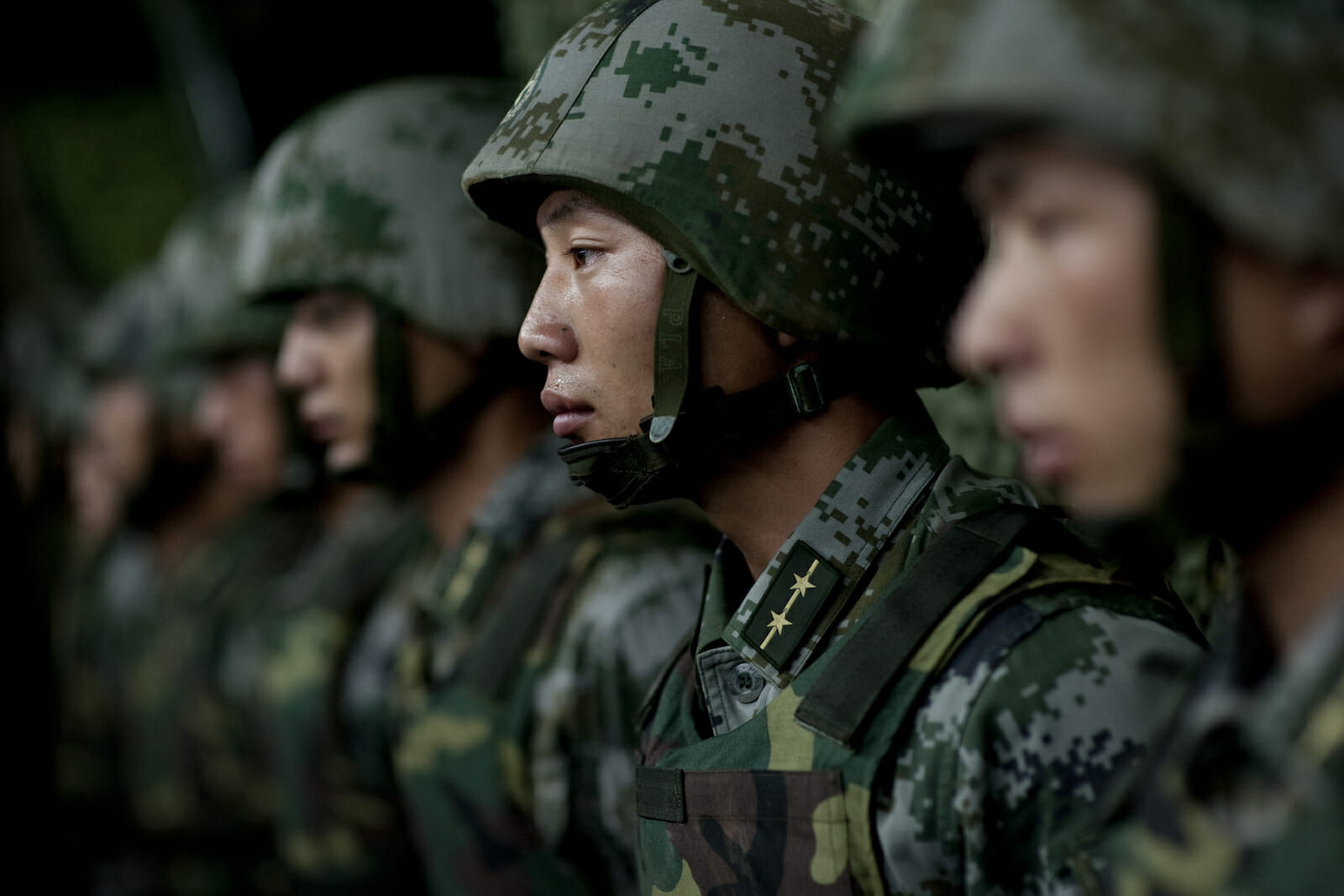
Beijing Needs a Softer Approach to Fighting Terrorism
Terrorists have long chosen as targets those places where hordes of people gather, in an apparent effort to maximize the destruction and sow fear in the general populace. Typical targets include popular restaurants, hotels, embassies, or public transport stations.
China’s terrorists have previously chosen a number of different targets, but seem intent this year to focus on attacking train stations. On Tuesday, in the third such incident in three months, six people were stabbed at a train station in Guangzhou, the capital of Guangdong Province in southern China. Police said they shot and injured one male assailant, though eyewitnesses report there were at least two knife-wielding attackers wearing white shirts, white pants and the small white skullcaps commonly worn by Uighurs and other Muslims in Xinjiang and other parts of China.
The attack in Guangzhou comes less than a week after two religious extremists carried out a similar attack at the Urumqi train station in far-western Xinjiang region, in an apparent suicide bombing that also killed one other person and wounded 79. The first such attack on a train station occurred in the southwestern city of Kunming in March, when eight assailants, armed with foot-long sabers and believed to be ethnic Uighurs, set upon men and women in the Kunming Railway Station. Twenty-nine people were killed in that attack and another 143 injured. The attacks on train stations may represent a new, coordinated approach, given prior scattered incidents involving attacks on policemen in Xinjiang, an alleged plane hijacking, and the crashing of a jeep into pedestrians at Beijing’s Tiananmen Gate in November.
The latest attacks also mark the geographic spread of terrorism in China, following the 2009 ethnic riots in Urumqi, when nearly 200 people were killed as Uighurs clashed with members of the majority ethnic Han Chinese community. Other incidents in the Xinjiang region over the past year have resulted in over 100 deaths.
The latest attack by terrorists is also being blamed on the Turkic-language speaking Uighurs, many of whom resent government controls on their culture and religion and reside in the province of Xinjiang. The Xinjiang region has a long history of ethnic violence which the government blames on Islamist militants and the East Turkestan Islamic Movement (ETIM). Members of ETIM seek an independent state to be named East Turkestan, covering an area to include parts of Turkey, Kazakhstan, Kyrgyzstan, Uzbekistan, Pakistan, Afghanistan, and the Xinjiang Uighur Autonomous Region. ETIM has been listed by the State Department as one of the more extreme separatist groups and is reputedly in alliance with the German-based World Uyghur Congress, a leading exile organization.
Beijing is adamantly opposed to an independent state, claiming that Xinjiang has been part of China for 2,000 years, although the region has either been on the fringe or outside of China’s empire for most of that time. The first attempt to incorporate the region came during the conquests of the Qing Dynasty (1644-1911) in the mid-18th century, and the name Xinjiang, or “new frontier,” only came into use in the 1880s. The Uighurs briefly achieved statehood from 1931 to 1934 after the fall of the Qing Dynasty and again from 1944 to 1949, before the Communists took power and used demobilized Chinese soldiers, drawing heavily on Soviet tactics for handling “nationalities,” to bring the region under their complete control. In 1955, Xinjiang was classified as an “autonomous region” of the People’s Republic of China.
Uighur exiles and many rights groups trace the cause of the current unrest on these heavy-handed government policies, including curbs on Islam and the Uighur people’s culture and language in this strategically located region. Uighurs have traditionally followed a moderate form of Sufi Islam, but in recent years have increasingly adopted practices more commonly seen in Saudi Arabia or Afghanistan, such as full-face veils for women. Rights groups claim Beijing has reacted to the increased religiosity by smothering Xinjiang with additional security measures and imposing restrictions on Uighur travel rights, culture, and religious practices.
Recent crackdowns have banned students from fasting during Ramadan, restricted religious teaching for children, and put limits on Uighur-language education. Authorities in Xinjiang now offer cash rewards ranging from 5,000 yuan to 50,000 yuan ($800-8,000) for reporting on a range of more than 50 activities. The activities include “violent terrorism training” to “growing long beards” and “wearing bizarre clothing” – although it is not the first time authorities have targeted beards and clothing such as burqas and veils. And in a move reminiscent of the days of Cultural Revolution, citizens who provide information about people who “say things that are not good for ethnic unity” or who “twist facts” (e.g. about the deadly 2009 riot) can be rewarded up to 500 yuan ($80).
The recent tightening of controls have led to several arrests and detentions, including the detention in January of Ilham Tohti, a Beijing economics professor who has championed Uighur rights and been charged with separatism. Tohti has challenged the government’s version of several incidents Chinese authorities blame on Uighurs, including the car crash on the edge of Tiananmen Square in November. Authorities in the U.S. have stopped short of drawing a connection between the attacks and ETIM, citing a lack of detailed evidence provided, and restrictions on the ability of journalists and international observers to independently verify the official media accounts.
While many analysts blame Uighur unrest on cultural restrictions, others point to economic factors, blaming the unrest on growing economic disparities between the majority Han and the ethnic Uighurs in this region rich in oil and minerals. Many Uighurs have long complained of economically marginalization, complaining the Han Chinese have flooded their towns and cities in recent years due to an explicit migration policy intended to bind the country more tightly. As a result of migration, the proportion of Han in Xinjiang rose dramatically between 1949 and 2008, from 6.7 percent to 40 percent – representing the largest demographic change ever to occur in a major region of China since the founding of the People’s Republic.
The Han migration has also accentuated the income disparities between Hans and Uighurs, as Hans hold more than 35 percent of the region’s high-income jobs compared to 13 percent for Uighurs. Beijing seems to have taken notice, reacting to the 2009 riots by pumping money into less-developed southern Xinjiang and creating vast new infrastructure in an attempt to increase economic activity, yet the minority Uighur population remains largely excluded from this growth. Following the attack in Kunming, President Xi Jinping has called for a two-track effort to include “all-out efforts” to capture and bring terrorists to justice, and greater efforts to include the Uighur population in economic growth. Train stations around the country will see armed and vigilant police, with increased CCTV monitoring of public transport areas and greater coordination among security organizations. Xi has also promised additional developmental efforts to create Uighur-owned businesses and jobs in Uighur communities.
While these efforts are laudable, they may not be enough. Beijing will need to effectively maintain a balance between greater and more focused policing efforts needed to stop the real terrorists, and addressing the potential social causes of the conflict. Suppression of the rights of ordinary Uighurs will only lead to more explosions of anger, so bans on religious and cultural practices need to be lifted and greater efforts made to fight the widespread prejudice they face throughout the country. Recent efforts in the Xinjiang region to encourage public policing will only foster more prejudice. Most Uighurs prefer to maintain a cultural distinction and autonomous rapport with China, and some are also content with integration. The purported mass arrest of more than 100 Uighurs in the hours following the attack in Urumqi, and crackdowns on “illegal activities” will only create more tension between Hans and Uighurs.
In promoting Han migration and curtailing the rights of the minority Uighurs, Beijing seems to have forgotten or chosen to ignore, its classification of Xinjiang as an “autonomous region” of the People’s Republic of China in 1955. “Autonomous” means the ability to exist or act separately from other things or people, as well as having the power or right to govern itself. The minority Uighur population should be granted a larger role and more input into local government policymaking and development projects. Without greater autonomy for the Uighurs of the Xinjiang Uighur Autonomous Region, any increased pressure on them will continue to spill over into violence and instability.

